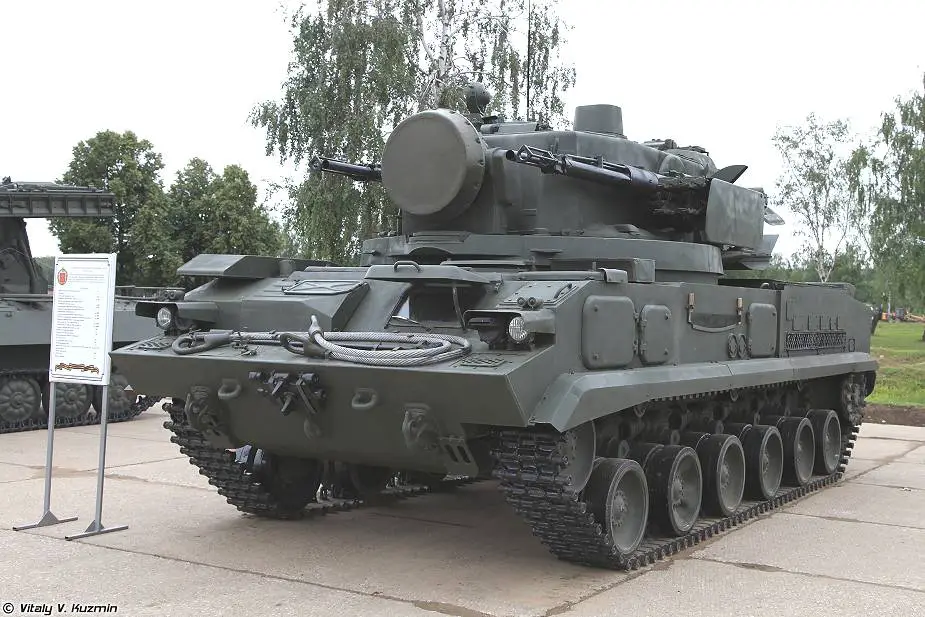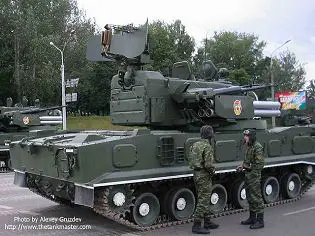- Army
- Air Defense Systems
- Anti-tank systems and vehicles
- Armored Vehicles
- Armoured personnel carriers
- Artillery Vehicles and Weapons
- Command Post
- Communication Vehicles and Systems
- Electronic Warfare
- Engineer | Maintenance Vehicles
- Infantry Fighting Vehicles
- Main Battle Tanks
- Missiles
- Tactical and Logistic Vehicles
- Radars
- Unmanned Systems
- Weapons
- Navy
- Air
2S6 2S6M Tungunska 2K22 2K22M SA-19 Grison
2S6/2S6M Tungunska 2K22 2K22M SA-19 Grison
Self-propelled anti-aircraft gun/missile air defense system - Russia

Description
The 2S6 Tunguska 2K22 (NATO code SA-19 Grison) is a Russian-made self-propelled air defense system that combines gun and missile armament. The development of the 2S6 Tunguska began in 1970 after a request by the Russian army for a new self-propelled anti-aircraft weapon system to replace the old ZSU-23-4 self-propelled anti-aircraft gun. The first version that entered service in 1986 was only equipped with four missiles, two on either side, in the ready-to-launch position. The second version to enter service with the Russian army, and the current production model vehicle, is designated the 2S6M or 2K22M, he has eight missiles, four to each side of the turret. The Tunguska vehicle uses a tracked chassis GM-352M which is also used for the ground-to-air missile system Buk-M1 SA-11 Gadfly. A typical 2K22/2K22M battery would consist of six 2S6/2S6M self-propelled air defense vehicles, six reload vehicles and associated support and maintenance vehicles. The 2S6 Tunguska is intended to protect tank and motorized units from low-flying aircraft and helicopters, some types of cruise-missile, as well as to engage light armor ground targets and manpower of the enemy.
2S6/2S6M Tungunska 2K22/2K22M variants:
- 2S6: first version of the vehicle with four missiles, two on either side of the turret.
- 2S6M: the production version with eight missiles
- 2S6M1: digital interface Ranzhir automated command-and-control system, new fire control system, new missile 9M311M with a maximum range of 10 km. Existing 2S6M Tunguska will be gradually upgraded to the new standard.
Technical Data
| Armament |
|
The turret of the 2S6M Tunguska is mounted in the center of the chassis and armed with two 30mm 2A38 twin cannons, one to each side of the turret. The 30 mm 2A38M cannon are built by the Tulamashzavod Joint Stock Company; each is fired in turn to give a maximum rate of fire of between 1,950 and 5,000 rds/min. The high rate of fire allows effective engagement of fast-moving targets that are within the zone of fire even for short time. The high accuracy of laying owing to a stabilized line of fire and automatic target tracking makes the gun armament highly effective in engaging air targets, including firing on the move. The 30 mm (2A38M) cannon are water-cooled, gas-operated, electrically fired weapon and each barrel has an automatic muzzle velocity measuring device that feeds data to the fire-control computer. The cannons can fire two types of ammunition, HE-T ( High-Explosive Tracer) and HE-I (High-Explosive Incendiary), which are normally belted together both fitted with the A-670 impact/time fuze. Mounted outwards and below the 30 mm cannon is a bank of four 9M311 SAMs (Surface-to-Air Missile) in two blocks of two, which can elevate vertically independently of each other. The 9M311 can engage aerial targets with altitudes between 15 and 3,500 m and from 2,400 to 8,000 m in slant range with the target having a maximum speed of 500 m/s. Russian sources quote the crossover range as being up to 4,000 m. The 9M311 is a bi-caliber two-stage air defense missile with a separable solid-propellant booster. The missile 9M311 is highly agile which allows it to engage fast and mobile targets. It's guided by radio commands.
|
| Design and protection |
|
The hull and turret of the 2S6M Tunguska are made in all-welded steel armor which provides protection against small arms firing and shell splinters. The driver is seated on the left front side of the chassis with the engine on the right. There are three crew members in the turret, the radar operator who is seated in the left front side of the turret, the commander on the right side, and the gunner to the rear in the center.
|
| Mobility |
| The 2S6M is based on the tracked chassis of the GM-352M which is also for the Buk-1M (NATO reporting name SA-11 Gadfly) and `Tor' SAM ground-to-air defense missile systems. The hydro-pneumatic suspension consists of each side with six dual rubber-tire road wheels with an idler at the front, a drive sprocket at the rear and three track-return rollers. A hydraulic track tensioning system is fitted as standard and this allows the driver to adjust the track tension without leaving his seat. The 2S6M Tunguska is motorized with a 4-cycle V12 water-cooled turbocharged diesel Model V-46-4 developing 780 hp at 2,000 rpm. The 2S6M Tunguska can run at a maximum road speed of 65km/h with a maximum road range of 500 km. The 2S6M Tunguska can negotiate a maximum vertical slope of 60% and a side slope of 30%. It can cross a trench of up to 2 m in width and a vertical obstacle of 1 m. The 2S6M Tunguska can ford a depth of 0.8m without preparation. |
| Accessories |
| The 2S6M is equipped with E-band surveillance parabolic radar, which is mounted on the turret rear. This has a maximum detection range of 18 km. J-band tracking radar is mounted on the front of the turret. This has a maximum tracking range of 16 km. The complete radar system is designated the 1RL144M. When a target is detected by the surveillance radar at a range of less than 8 km, this can be transferred automatically to the tracking radar on the front of the turret. The commander uses a console to select the type of weapons and then engage the target. The commander or the gunner can open fire. The radar operator has three consoles that he uses to control the tracking and fire-control radar which sends information such as range, bearing and elevation to the fire-control computer which in turn computes the laying commands for the weapons. Standard equipment of 2S6M Tunguska includes a heating system, 1V16 internal communications system, fire detection and suppression system, land navigation system, NBC system, night vision aids and internal and external communications equipment. |
| Combat use |
| The 2S6M Tunguska-M system battery comprises 2S6M combat vehicles (six in a battery), 9M311 air defense missiles (eight pieces for each launcher vehicle), 30mm artillery rounds, and 2F77M transloaders (up to three in a battery), maintenance facilities and training aids. |
Specifications
| Armament | Armor |
| Two 2A38 30mm twin cannons, eight ground-to-air missiles 9M311 or 9M311M SA-19 Grison. | Protection against the firing of small arms and artillery shell splinters. |
| Country users | Weight |
| Belarus, India, Morocco, Russia, and Ukraine. | 34,000 kg |
| Designer Country | Speed |
| Russia | 65 km/h on road |
| Accessories | Range |
| Surveillance and tracking radar, computerized fire control system, heating, internal communications system, fire detection and suppression system, land navigation system, NBC system, night vision aids, and internal/external communications equipment. | 500km |
| Crew | Dimensions |
| 4 | Length: 7.93 m; Width: 3.23 m; Height: 3.35 m |
Details View
 |
|
 |
 |
 |
 |
Pictures - Video



























